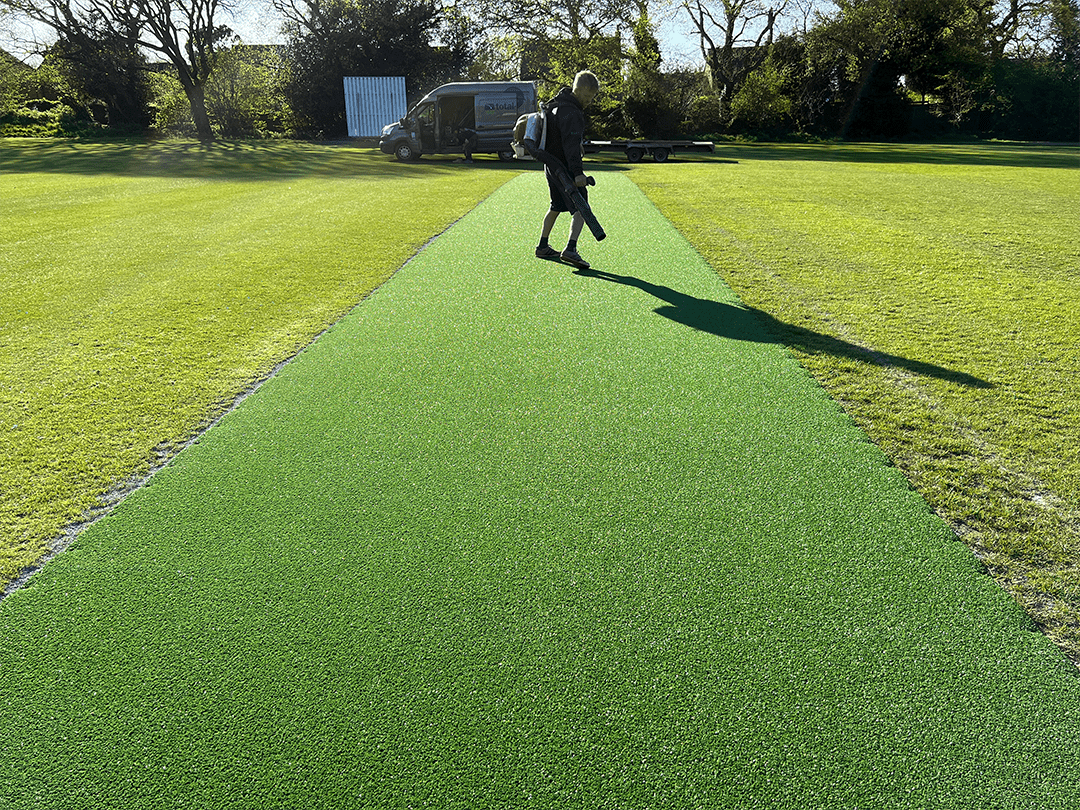
5 Best Practices for Maintaining Artificial Cricket Pitches In Summer
Maintaining your artificial cricket pitch as summer approaches is essential to keeping it in top shape for the playing season.
When preparing cricket pitches, synthetic fields need special maintenance that helps them survive both the weather change and vigorous play, especially when compared to natural pitches.
Every action, from routine cleaning to thoughtful watering methods (yes, watering!), is intended to increase longevity and improve the functionality of your pitch. At total-play, we want to share our expertise so you can make informed decisions about your club’s playing surfaces.
To simplify the process, we’ll go over five crucial tips in this blog to maintain the best possible condition for your artificial cricket pitch in the summertime.
If you’re in charge of a school or community sports organisation, these pointers will assist you in giving cricket players the greatest playing field possible.
Let’s explore the best ways to keep your summertime artificial cricket pitch maintained.
1. Regular Cleaning


Artificial cricket pitches require frequent maintenance, particularly during summer. It entails frequently clearing off any debris that might build up on the surface, such as leaves, dirt, stones and rubbish.
With the help of a hard brush and leaf blower, you can easily clean your cricket pitch.
Eliminating organic debris from the surface is essential as this stops moss and weeds from growing on the edge, which can harm the pitch’s quality and playability in the long term.
In addition to making your cricket experience enjoyable, preparing cricket pitches for the summer season allows you to keep the surface free from dirt and unwanted growth, ensuring a smooth, even surface at all times.
2. Controlling Weeds and Moss
When preparing cricket pitches for summer, it is essential that you prevent the development of weeds and moss in the process. There is constant maintenance in damp areas where such growth is far more common than anticipated.
Moreover, it’s crucial to apply comprehensive procedures that are made especially for artificial surfaces to avoid these uninvited plants. Algae and moss killers are products made to safely remove these growths without damaging synthetic materials.
Furthermore, pulling weeds by hand is also advised. This entails hand-weeding the area or using herbicides that are safe for artificial cricket pitches. By using a focused approach, the pitch’s quality and playability are preserved by keeping it clear of invasive plants and tidy.
3. Surface Levelling and Decompaction
Artificial cricket pitches require frequent surface levelling and decompaction since the infill materials, such as sand or rubber crumbs, tend to compact with repeated use and environmental variables.
Compaction can obstruct appropriate drainage and alter how the ball interacts with the pitch. To maintain the desired play qualities of the cricket pitch and guarantee consistent performance, it is recommended to use specialised rakes or brushes regularly to redistribute and level the infill.
By reducing uneven wear and tear, this maintenance regimen prolongs the surface’s lifespan while also preserving its structural integrity. Pitch overall quality and safety are greatly enhanced by efficient levelling and decompaction.
4. Look Out For Any Damage
It’s crucial to regularly examine an artificial cricket pitch and look out for wear and tear, such as rips, loose seams, or uneven patches. Regular monitoring makes it possible to identify these problems early on, which is essential to preserving the pitch’s usefulness and integrity.
Timely repairs keep little damage from getting worse, increasing the cricket pitch’s life and guaranteeing players’ safety. By preventing expensive overhauls, this proactive method maximises the return on investment while simultaneously improving the surface’s performance qualities.
Keeping the pitch in good condition is important for both the general standard of play and the safety requirements for both competitive and leisure games.
5. Watering
While it’s not always as important as it is for real grass, watering artificial cricket grounds comes in handy on hot summer days. The temperature of the surface may be considerably lowered by sprinkling water on it, making the playing surface more pleasant.
This is particularly crucial in the hours of maximum sunshine when the heat can cause synthetic fabrics to become uncomfortable. Watering also aids in settling infill materials, which might shift during play, such as sand or rubber crumbs.
This improves the pitch’s overall playability and safety by keeping the playing surface level and reducing the quantity of dust created during games.
Contact total-play For Impeccable Artificial Cricket Pitches!
Are you ready to switch to the unparalleled performance of artificial cricket pitches? Choose total-play’s artificial cricket pitches that are here to revolutionise the cricketing landscape.
From installing top-notch cricket pitches to offering tips to excel at cricket pitch maintenance, we are here for you.
At total-play, we are always inspired to offer products that are better than what’s available in the current market and this commitment results in trusted and exceptional products. We offer best-in-class solutions to our clients, making us the preferred choice for clubs and venues worldwide.
Contact us to set the stage for unforgettable cricketing moments and equip your club with world-class products and services.
Back to news









